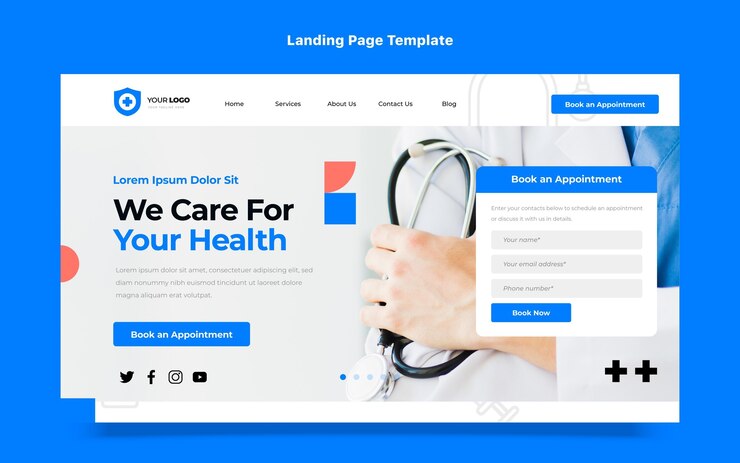In today’s digital age, a strong online presence is crucial for healthcare providers to connect with patients and deliver quality services efficiently. A well-designed website is the cornerstone of this digital presence, offering a platform for communication, information dissemination, and appointment scheduling. However, achieving an effective healthcare web design requires navigating through potential pitfalls. Let’s explore these pitfalls and discover solutions with OzBizTech, your partner in crafting seamless online experiences.
Importance of Effective Web Design in the Healthcare Industry:
In today’s digital age, having a well-designed website is crucial for healthcare organizations. A professionally designed website can enhance your online presence, attract new patients, and establish credibility. It serves as a vital tool to educate patients about services, provide important medical information, and facilitate easy appointment scheduling.
1.Accessibility: A user-friendly website ensures that patients can easily access vital information, regardless of their location or device.
2.Trust and Credibility: A professionally designed website instills confidence in patients, showcasing the professionalism and reliability of the healthcare provider.
3.Patient Engagement: Interactive features and intuitive navigation foster engagement, encouraging patients to explore services and resources.
4.Brand Visibility: A well-designed website strengthens brand recognition and distinguishes the healthcare provider from competitors.
5.Operational Efficiency: Streamlined processes such as appointment scheduling and prescription requests enhance operational efficiency, benefiting both patients and staff.
Common pitfalls in Healthcare Web Design:
1. Slow loading times and how to optimize website speed
One of the most common mistakes in healthcare web design is having a website that takes forever to load. In today’s fast-paced world, users expect websites to load quickly, and if they have to wait too long, they will likely abandon the site and move on to a competitor. To optimize website speed, it is important to minimize the file size of images and videos, utilize caching techniques, and choose a reliable hosting provider.
2. Lack of mobile responsiveness and the importance of responsive design
With the increasing use of smartphones and tablets, it is crucial for healthcare websites to be mobile responsive. A lack of mobile responsiveness can lead to a poor user experience, as users may have to pinch and zoom to read content or navigate through the site. Responsive design ensures that the website adapts to different screen sizes and provides a seamless experience across all devices.
3. Poor navigation and user experience (UX) issues
A confusing or cluttered navigation can frustrate users and make it difficult for them to find the information they are looking for. It is important to have a clear and intuitive navigation menu that allows users to easily navigate through different sections of the website. Additionally, incorporating user experience (UX) design principles, such as clear call-to-action buttons and logical information hierarchy, can greatly enhance the overall user experience.
4. Inadequate accessibility for individuals with disabilities
Accessibility is a key consideration in healthcare web design, as it ensures that individuals with disabilities can access and navigate the website. Common accessibility issues include insufficient color contrast, lack of alternative text for images, and inaccessible forms. By following web accessibility guidelines, such as the Web Content Accessibility Guidelines (WCAG), healthcare websites can ensure that they are inclusive and accessible to all users.
5. Outdated or cluttered design and the benefits of a clean, modern layout
An outdated or cluttered design can make a healthcare website appear unprofessional and untrustworthy. It is important to keep the design clean, modern, and in line with current design trends. A clean layout with ample white space not only enhances the visual appeal of the website but also improves readability and comprehension of the content. Implementing a consistent color scheme, using high-quality images, and incorporating modern typography can further enhance the overall design.
Solutions to Avoid Common Pitfalls in Healthcare Web Design:
To avoid the common pitfalls in healthcare web design, it is important to prioritize user experience and follow best practices. Here are some practical solutions:
1.Hiring a Professional Web Designer: Partnering with experienced web designers who specialize in healthcare can ensure your website is tailored to meet the unique needs of your industry and audience.
2. Conducting User Testing and Feedback: Regularly soliciting feedback from real users can provide valuable insights into areas for improvement, allowing you to fine-tune your website for optimal performance.
3. Implementing Responsive Design Principles: Adopting responsive design techniques ensures your website adapts seamlessly to various devices and screen sizes, providing a consistent user experience across all platforms.
4. Streamlining Navigation and Improving User Experience: Simplifying navigation menus and organizing content in a logical manner can help users find information quickly and easily.
5. Consistent Branding and Design Elements: Establishing a cohesive visual identity across your website reinforces brand recognition and instills confidence in your professionalism.
6. Simplifying Layouts and Prioritizing Content: Embracing minimalist design principles and prioritizing essential content can enhance readability and guide users towards key information.
7. Including Clear Call-to-Actions: Strategically placing prominent call-to-action buttons throughout your website encourages users to take the next step, whether it’s scheduling an appointment or downloading patient resources.
Conclusion
In the competitive landscape of healthcare, a well-designed website is a powerful tool for attracting and retaining patients. By avoiding common pitfalls such as slow loading times, poor navigation, and inconsistent branding, and implementing solutions such as responsive design and clear call-to-actions, you can create a healthcare website that not only meets but exceeds user expectations. At OzBizTech, we specialize in healthcare web design solutions tailored to your unique needs. Contact us today at 1300 095 747 or email us at info@ozbiztech.com.au to elevate your online presence and stand out in the digital realm.





